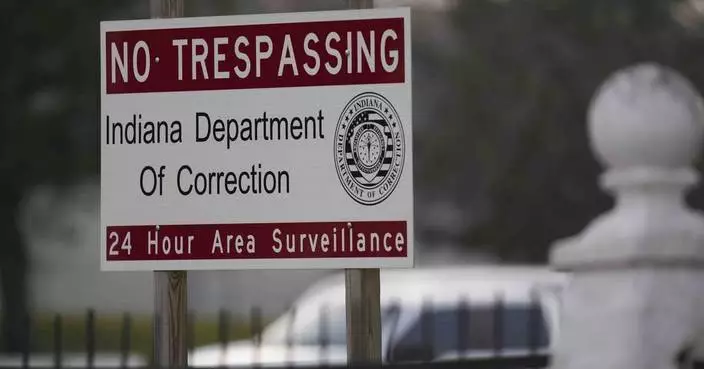A police officer in Minnesota fatally shot a man after the man rear-ended the officer's marked SUV, then got out of his car and started fighting with the officer, authorities said.
Authorities have not said whether the man had a weapon when the St. Paul police officer shot him during the fight Sunday evening. Police Sgt. Mike Ernster said the officer's body camera was activated, but the video has not been released.
Ernster said the officer was stopped at a stop sign in the city's Midway neighborhood when he was "suddenly struck from behind by another motor vehicle. The officer exited his vehicle and was immediately confronted by the driver of the striking vehicle and a fight ensued."

Investigators work the scene of an officer-involved shooting in the Midway area of St. Paul, Minn., on Sunday, Sept. 15, 2019. A St. Paul police officer fatally shot a man who rear-ended his squad car and fought with the officer, according to the police department. (John AuteyPioneer Press via AP)
The Ramsey County medical examiner's office said Ronald Davis, 31, of St. Paul was the man who was shot by the officer. An autopsy was performed Monday, but there are no preliminary findings yet and the death is still under investigation.
The shooting comes as police deal with a stretch of violence in the city that led police Chief Todd Axtell to beef up street patrols.
In a Facebook post, Axtell said the officer was "faced with one of the most gut-wrenching situations imaginable" and it "is a tragedy for everyone involved." He extended condolences to the family of the man who died and said his department will do what it can to support the officer.
The state Bureau of Criminal Apprehension is investigating. The bureau said Monday that it was conducting interviews with those involved and with witnesses.
According to local media reports, at the time of the incident, someone could be heard on police emergency radio shouting, "Drop the knife, drop the knife!"
Ernster confirmed that the St. Paul officer made those radio transmissions, but said that state investigators were processing the scene and he did not know whether a knife had been recovered.
The name of the officer was not immediately released. The officer was placed on administrative leave, which is standard in police shootings.
The St. Paul Pioneer Press reported that a City Council member and the head of the St. Paul NAACP joined community members in calling for the release of the officer's body camera footage.
"Our body cameras are supposed to capture moments gone wrong, moments of tragedy, everything in between and I just think we really, really need to be able to see that right now," City Council member Mitra Jalali Nelson said. "I think one of the most important things we need is transparency."
The Minneapolis-St. Paul area has had several shootings by police officers in recent years that have sparked angry protests, including the 2016 killing of a black driver, Philando Castile, by an officer in the Twin Cities suburb of Falcon Heights. Castile's girlfriend streamed the immediate aftermath of the shooting on Facebook.
On Sept. 7, police fatally shot 30-year-old Brian Quinones in the suburb of Richfield after they say he failed to stop for a red light in Edina and wouldn't pull over. The city of Edina says Quinones "confronted officers with a knife" before he was shot. Quinones livestreamed a video of himself as he was driving, being pursued by police. The shooting can be heard, but not seen, on his video.
Afterward, his brother told Minnesota Public Radio News that Quinones had been having suicidal thoughts.
BANGKOK (AP) — Shares skidded Thursday in Asia after U.S. stocks tumbled to one of their worst days of the year when the Federal Reserve hinted it may deliver fewer rate cuts in 2025 than earlier thought.
The Fed cut its key rate by a quarter of a percentage point to between 4.25% and 4.5%, as expected. Other major central banks have stood pat this week, with the Bank of Japan opting Thursday to keep its benchmark rate at 0.25%. That decision, which also was no surprise, pushed the dollar higher against the Japanese yen.
Asian markets fell, but generally by less than 2%, with Tokyo's Nikkei 225 falling 0.7% to 38,813.58. The dollar was trading at 156.44 yen, up from 154.79 yen.
A weaker yen tends to push prices higher in Japan, which depends heavily on imports, and that in turn raises pressure on the Bank of Japan to raise rates. Analysts say they expect a BOJ rate hike in January, but also that the central bank is wary of big changes as it waits to see possible shocks from President-elect Donald Trump's policies on tariffs.
There are “high uncertainties” surrounding Japan's business outlook and prices and developments in foreign economies and commodity prices, the BOJ said in a statement.
Chinese markets also declined. The Hang Seng index fell 0.5% to 19,760.10, while the Shanghai Composite index dropped 0.4% to 3,370.03.
Australia's S&P/ASX 200 shed 1.7% to 8,168.20, while the Kospi in South Korea slipped 2% to 2,435.93. India's Sensex fell 1.1%.
In Taiwan, the Taiex lost 1%, while Bangkok's SET fell 1.1%.
On Wednesday, the S&P 500 fell 3%, just shy of its biggest loss for the year, to close at 5,872.16. The Dow Jones Industrial Average lost 1,123 points, or 2.6%, to 42,326.87, and the Nasdaq composite dropped 3.6% to 19,392.69.
The Russell 2000 index of small-cap stocks tumbled 4.4%.
Wednesday's rate cut is the third this year after it began in September to lower rates from a two-decade high to support the job market. Wall Street loves easier interest rates, but the cut was already widely expected and investors were more focused on how much more the Fed will cut next year.
A lot is riding on it, particularly after expectations for a series of cuts in 2025 helped the U.S. stock market set an all-time high 57 times so far in 2024.
Fed officials released projections on Wednesday showing the median expectation among them is for two more cuts to the federal funds rate in 2025, or half a percentage point’s worth. That’s down from the four cuts expected just three months ago.
“We are in a new phase of the process,” Fed Chair Jerome Powell said.
Asked why Fed officials are looking to slow their cuts, he pointed to how well the job market is performing overall and how recent inflation readings have picked up.
Powell said some Fed officials, but not all, are also already trying to incorporate uncertainties inherent in a new administration coming into the White House. Worries are rising on Wall Street that President-elect Donald Trump’s preference for tariffs and other policies could further fuel inflation.
“When the path is uncertain, you go a little slower,” Powell said. It’s “not unlike driving on a foggy night or walking into a dark room full of furniture. You just slow down.”
The reduced expectations for 2025 rate cuts sent Treasury yields higher, squeezing the stock market.
The yield on the 10-year Treasury rose to 4.51% from 4.40% late Tuesday, which is a notable move for the bond market. The two-year yield, which more closely tracks expectations for Fed action, climbed to 4.35% from 4.25%.
Nvidia, the superstar stock responsible for a chunk of Wall Street’s rally to records in recent years, fell 1.1% to extend its weekslong funk. It has dropped more than 13% from its record set last month and fallen in nine of the last 10 days as its big momentum slows.
In other dealings early Thursday, U.S. benchmark crude oil gave up 46 cents to $69.56 per barrel in electronic trading on the New York Mercantile Exchange. Brent crude, the international standard, fell 42 cents to $72.97 per barrel.
The euro rose to $1.0396 from $1.0355.

People walk on Wall Street in New York's Financial District on Wednesday, Dec. 18, 2024. (AP Photo/Peter Morgan, File)

A board above the floor of the New York Stock Exchange shows the closing number for the Dow Jones industrial average, Wednesday, Dec. 18, 2024. (AP Photo/Richard Drew)

TV cameraman films near the screens showing the Korea Composite Stock Price Index (KOSPI), left, the foreign exchange rate between U.S. dollar and South Korean won, center, and South Korean won and the Korean Securities Dealers Automated Quotations (KOSDAQ) at a foreign exchange dealing room in Seoul, South Korea, Thursday, Dec. 19, 2024. (AP Photo/Lee Jin-man)

A currency trader walks by the screens showing the Korea Composite Stock Price Index (KOSPI), left, and the foreign exchange rate between U.S. dollar and South Korean won at a foreign exchange dealing room in Seoul, South Korea, Thursday, Dec. 19, 2024. (AP Photo/Lee Jin-man)














